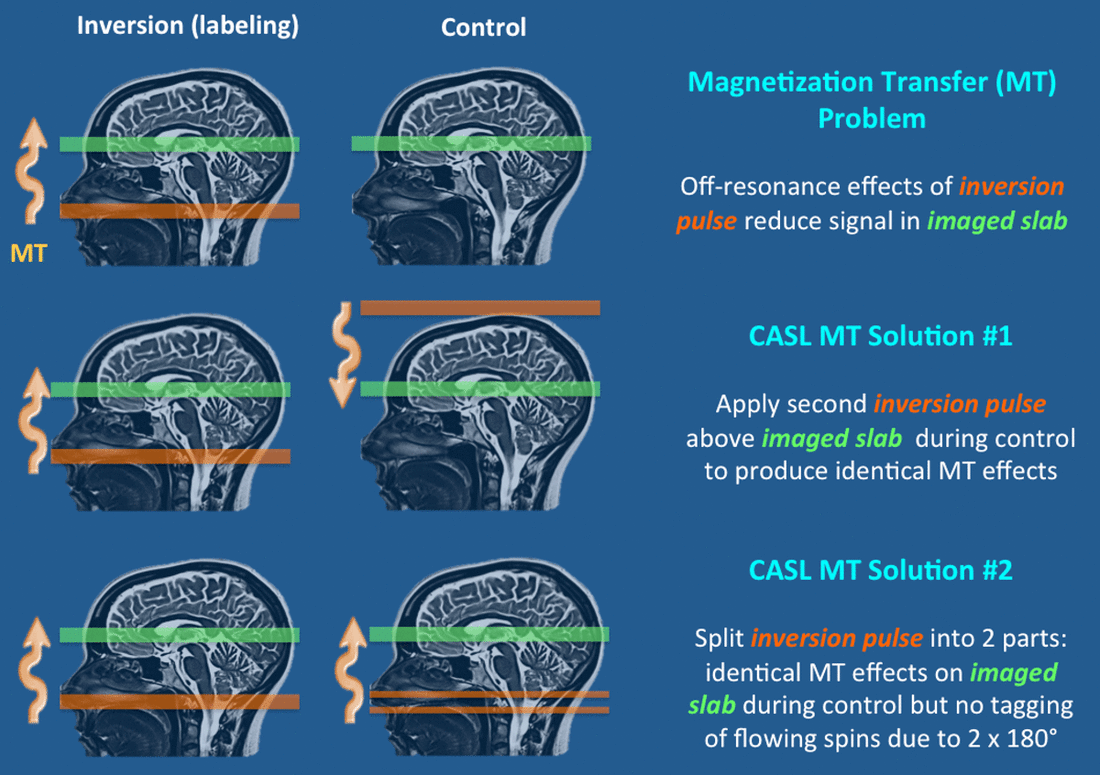The MT phenomenon occurs in normal imaging, but usually is not noticeable because it affects tissue signal in adjacent slices by only a few percent. In ASL, however, where the change in signal between tagged and control images is less than 1%, unwanted MT effects may overwhelm detection of the desired flow-related changes.
All ASL techniques must therefore address how to cancel or diminish this MT effect. An illustration of the "MT Problem" and two solutions possible with the CASL method is given below.
In the second row the original CASL solution is illustrated. Here the control image is obtained using a second inversion pulse identical to the first but applied on the opposite side of the imaged slice. The MT effects within the imaged slice are the same between Labeling and Control; they are eliminated when the two images are subtracted.
"CASL Solution #2" a modification of the original technique by Alsop and Detre (1998). Here, the inversion pulse played out during the Control sequence is split into two parts (sidebands) by amplitude modulation. Since the sidebands have half the amplitude of the original pulse and are very close together, the MT effect on the imaged slice remains unchanged and disappears when the sequences are subtracted. The split pulse results in no net inversion of flowing spins in the Control sequence since the pair acts as two 180° pulses = 360° (a double inversion) when placed side-by-side.
Advanced Discussion (show/hide)»
The idea that flowing spins can be selectively inverted by the combination of a radiofrequency (RF)-pulse AND a gradient is an interesting and unique feature of CASL and pCASL. The underlying physics is a little complex and introduces the concept of flow-related adiabatic inversion.
The general adiabatic phenomenon has been previously introduced in a prior Q&A. In brief, adiabatic excitation is a special type of RF-stimulation that occurs only under certain limited conditions and produces a nearly perfect inversion of net magnetization (M) that is relatively tolerant to B1-field inhomogeneities. The phenomenon was described in the early days of NMR in which a specimen in a constant magnetic field was subjected to continuous RF-excitation swept over a range of frequencies from far below to far above the resonance frequency. Provided the B1-field was strong enough and applied slowly enough (the adiabatic condition), the net magnetization (M) could be nutated with a complete inversion by the end of the sweep.
Surprisingly, adiabatic inversion of flowing spins in ASL can occur even when the RF-field is maintained at a constant frequency and amplitude. This happens if a strong spatial gradient oriented in the direction of flow is applied concomitantly with RF-excitation. As the flowing spins move within this gradient their resonant frequencies change by location. What looks like a stationary RF-field to the outside world seems like a sweeping RF-field to the flowing spins. Thus they can undergo adiabatic following and inversion provided their velocities (v) are neither too small nor too large compared the T2 relaxation time of arterial blood, strength of the gradient (G), and magnitude of the effective field (≈ B1) according to the relationship:
Alsop DC, Detre JA. Multisection cerebral blood flow MR imaging with continuous arterial spin labeling. Radiology 1998; 208:410-416. (improvement of the CASL technique using an amplitude modulated inversion pulse to self-correct for off-resonance effects)
Williams DS, Detre JA, Leigh JS, Koretsky AP. Magnetic resonance imaging of perfusion using spin inversion of arterial water. Proc Natl Acad Sci USA 1992; 89:212-216. (first demonstration of ASL, using a single-slice continuous technique in a rat brain, later known as CASL)
Wong EC, Buxton RB, Frank LR. Implementation of quantitative perfusion imaging techniques for functional brain mapping using pulsed arterial spin labeling. NMR in Biomed 1997; 10:237-249. (comparison of CASL to pulsed methods)
Can you briefly explain the difference between the various ASL methods? Which is the best?
What is pCASL and how does it differ from CASL and PASL?

